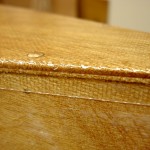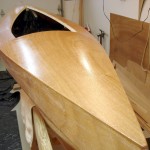Excuses for no “before” or “during” pictures:
- The dog ate them. Ooops, we don’t have a dog.
- You’ve seen this stuff before.
- Didn’t want to get poxy all over the camera.
- Forgot.
- Too stressed by the messy challenge.

 Glassing the deck was simpler because it’s smaller than glassing the full hull. It was more difficult because it consists of two overlapping pieces. Other than that, it went quickly and with a little less mess than the big job.
Glassing the deck was simpler because it’s smaller than glassing the full hull. It was more difficult because it consists of two overlapping pieces. Other than that, it went quickly and with a little less mess than the big job.
Like many woodworking jobs, prep takes almost as long as doing the job. Prep in this case included much better sanding than the hull because the deck will be finished bright and every little scratch is visible through the glass: 120, 150, 220, 320, brush off, vacuum, wipe with tack cloth, wipe with alcohol.
Hint: wipe on a liberal wetting of alcohol. This briefly simulates a clear finish, highlighting any remaining scratches. It evaporates off quickly, leaving no stains.
Prep also included applying package tape where I don’t want new fiberglass sticking to the hull. The tape was applied with it’s top edge right at the line which will be the bottom of the rubrail, 3/4 inch below the rounded over deck edge.
After about 8 hours of cure, I scored the fiberglass that was hanging over the side with a sharp knife. That score line is about the middle of where the rubrail will be, about 3/8 inch below the deck. Then, I pulled the excess fiberglass upward, breaking off at the score line. Score and rip. Neat!
That deck sure looks purrty. Have done some glass work and I don’t envy you the sanding prep work.
Cheers — Larry
hey Bob-
Eva Too is really looking great…I’ve been up to my elbows lately but am still finding the time to ‘tune in’ when ever I can on your projects. Loved the pencil box as well-that and the grease box were on my list too! no time for my own projects these days-
Funny, I have a gentleman on the East coast asking if I’d consider building him a wooden ‘Europe’ hull. He has an older glass model but would like one in wood. The Europe is similar to a Moth or a Tasar style sailing dinghy if you’re familiar with those.
My fear of getting back into that work is just what you’re covering here- ‘the glass work’ and oh how I hate sanding! 😉
all the best-
keep well.
Tom
Thanks Tom! I’ve been watching your projects too. Very nice.
I saw someone on another blog mention recently they didn’t know how people like you, mentioned your name specifically, could actually make money using only hand tools (the old power -vs- hand discussion). I was tempted to suggest that you can earn what you do because you create one one of a kind pieces that are as much art as furniture and people are willing to pay handsomely for those. No hand tool worker would survive trying to build kitchen cabinets that compete on price with Lowes or Home Depot.
Now, if that gentleman you know is willing to wait as long as it takes and pay a very slow boat builder by the hour …
Keep havin’ fun.
Hi again,
I still chuckle to myself when ever I hear that people think I actually make money doing this ! A labour of love my friend….a labour of love.
The Europe Dinghy should be a very interesting project. We just finally located a source for the table of off sets- not an easy task at all. The boat has very strict allowances to be classed as a Europe and the only plans that seem to exist are from 1976 France.
It’ll be interesting to see how it plays out.
keep well.
Bob,
You did a wonderful job glassing Eva Too! I have a feeling the prep work is much more involved than anything I might tackle; I can appreciate the huge amount of elbow grease you put into it.
It sure looks wonderful at this stage!
Al
Thanks Al. Actually, I see you putting that much prep into the pieces you create. You don’t whine about it as much as I do. 🙂
Just wait. As they say in the advertisements for cheap junk on TV, “There’s MORE!”
Very nice job. I am in the process of re decking an older Highlander sailboat. Hull was one of the original fiberglass models. “bullet-proof” Deck was plywood. Lasted over 40 years. Trying to replace with the least expensive but longest lasting, somewhat, maintaince free material.
Original idea was to purchase mahogany plywood and varnish over. Others suggested to use thin mahogany flooring boards. Liked the idea of this but keep coming back to the annual strip and varnish.
Do you have any suggestions?
Price does play a factor as I am facing three in college soon. I can purchase a used plastic Highlander for around $4500 but am trying to rekindle my Great Grandfather’s oyster sailboat building skills. It would mean much more if I did this myself.
Think you can understand.
Email back at kcpierson@att.net
Thanks for your expertise.
Chris,
Being a simple small boat builder, I can’t pretend to be the expert you think I am. So, take the following with a big grain of salt. If you don’t already follow or use the WoodenBoat forums, this is exactly the kind of question for which they are very valuable. Try the Building/Repair forum at: http://forum.woodenboat.com/forumdisplay.php?f=1
Now, if it were my boat…
Is your Highlander is a 20 footer, the “class” boat, or one of those day cruisers with a cabin? If it is the boat I think it is, the class boat, I would redeck with marine grade plywood. Yes, it is expensive, and you would likely need the better part of 6 sheets. Its value is its quality. I would definitely not use the flooring material advice. That stuff will rot inside of 3 years. Your labor, whether you pay for it or do it yourself, will be much more valuable than even the most expensive materials, so don’t scrimp on materials. Clear coating with 2 coats of epoxy will provide weatherproofing, especially on edges before installation. Epoxy doesn’t have any UV protection, so you’ll need added finish. The choices are 3 and depend mostly on your preference for showiness. Paint is easiest. Varnish is the hardest and needs the most renewal, as you have already mentioned.
An in-between choice is Sikkens Marine Cetol. It is an almost clear (has an amber cast) finish that is tough and doesn’t need renewal as often as varnish. Maynard Bray’s “Constanza” on the May/June 2009 cover of Wooden Boat magazine has a Cetol deck. He says it has been on the boat 10 years and only now needs to be stripped and redone. His says “I do a quick light sanding with 220 grit, then brush on a new coat annually using a throwaway brush.” That makes Cetol my choice too.
Whatever choice you make, enjoy the adventure!